Early inhabitants and their life (Old Stone Age and Jomon period)
It was more than 10,000 years ago that people first began to live in the Kamakura area. This estimation comes from objects--obsidian tools and a knife-shaped stone tool--belonging to the Old Stone Age (ca.100,000 B.C.-10,000 B.C.), which were unearthed at excavation sites nearby Jorakuji Temple (常楽寺) in Ofuna (大船).Then came the Jomon Period (縄文時代). This period, lasting from 10,000 B.C. to 300 B.C., was characterized by the use of earthenware decorated with cord-marked motifs called jomon (縄文).
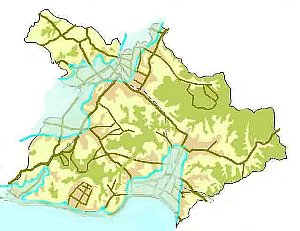 In the early Jomon period, due to warmer temperatures, the coastline advanced as far as most of the present flat residential areas. The Ofuna Inlet expanded far inland to present-day Totsuka-ku (戸塚区) and Sakae-ku (栄区) in Yokohama and reached as far as 8,000 meters to the north and was 800 meters wide.
In the early Jomon period, due to warmer temperatures, the coastline advanced as far as most of the present flat residential areas. The Ofuna Inlet expanded far inland to present-day Totsuka-ku (戸塚区) and Sakae-ku (栄区) in Yokohama and reached as far as 8,000 meters to the north and was 800 meters wide.The oldest pottery, though only a few fragments, unearthed on present-day hillsides belong to the period between 7,500 B.C. and 5,000 B.C. Jomon culture developed primarily in the Middle Jomon period. Remains have been found in many locations all across the Kamakura area.
In the Late Jomon period the land area expanded because of the receding sea level, brought about by a cooler climate, and movements in the earth's crust. Owing to developments in the techniques for making utensils and to better living conditions, various kinds of vessels were produced--clay teapots, cups, bowls, plates, pots, vases, ewers and incense burners.
The people built plain pit houses and settled on the tableland areas. Bows and arrows came to be used. Obsidian arrowheads found buried here are thought to have been brought from the Izu Peninsula, which would suggest trade relations with distant areas.
Harpoon heads and fishhooks--made from the bones and horns of birds and animals--and sinkers or weights for fishing nets have been found. In addition, stone plates, stone pestles, mortars, and grinding or pounding stones have been found for cracking open and grinding various kinds of nuts, among them walnuts, chestnuts, and horse chestnuts (tochi).
From hunting to farming (Yayoi period: 弥生時代)
This period (ca. 300 B.C.-300 A.D.) is distinguished by a type of pottery distinct from that of the former period. Called Yayoi-shiki (弥生式) after the place where it was first unearthed (the Yayoi section of Bunkyo Ward, Tokyo: 東京都文京区弥生町), it is reddish-orange with a smooth finish. Bronze and iron tools came to be used, and even glass-making and weaving techniques were introduced.At the beginning of the Yayoi period, the sea receded almost to the present-day coastline, leaving space for fields. This provided land for the rice-paddy cultivation introduced from China. The way of life radically changed from hunting and gathering to farming, based on rice-growing. The earliest pieces of Yayoi pottery found in Kamakura are from the Middle Yayoi period. Many Yayoi period sites have been found across this area.
Only one tomb mound survived in Kamakura (Kofun period, 古墳時代)
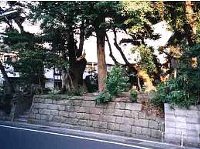
|
| Wadazuka Mound |
Although a cluster of tomb mounds were known to have existed in Kamakura, the Wadazuka Mound (和田塚) is the only mounded earth tomb that remains to this day. It was once called the Mujodozuka Mound (無常堂塚) and clay haniwa (埴輪) funerary objects in the shape of cylinders and horses were found there.
Towards the end of the period, the construction method changed from a tomb mound with a "vertical hole, stone chamber" to one with a "horizontal hole, stone chamber," known in Japanese as oketsubo (横穴墓), or yokoana (横穴). Originally there were around 170 oketsubo, but only about half have survived due to recent housing development. The Sembagayatsu (洗馬ケ谷) cave wall in Tamanawa (玉縄) has a drawing depicting fighting figures on ships, and is designated a Historic Site by the city.
Kamakura had large local government offices in Nara period (奈良時代: 710-784)
In its early years, Kamakura was generally thought to have been a nondescript fishing and farming village. Recent excavation work, however, has brought to light another aspect. It was discovered that some temples and shrines had been built in appropriate spots, and the presumption now is that large-scale, local government offices were located around Yuigahama, extending as far as the Imakoji (今小路) area in the southern part of present-day Ogigayatsu.Amanawa Shimmeigu Shrine (甘縄神明宮) in Hase dates back to the early eighth century. Sugimotodera Temple (杉本寺), built in this period by a priest named Gyoki (行基, 668-749), is one of the oldest temples in Kamakura.
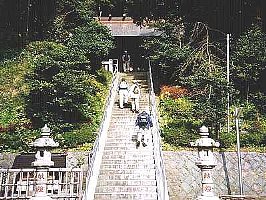
Amanawa Shimmeigu Shrine |
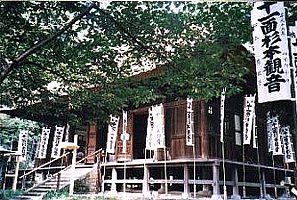
Sugimotodera Temple |
Kamakura in the Heian period (平安時代: 794-around 1180), when the capital was in Kyoto
The name, Kamakura, along with other neighboring area names, are found in records from the Heian period (794-1185/92): Kamakura (鎌倉), Numahama (沼浜), Sakitachi (埼立), Egaya (荏草), Kajiwara (梶原), Sakado (尺度), and Oshima (大島). Another record shows that Gongoro Kagemasa (鎌倉権五郎景正, 11th century), a noted warrior, donated his ancestral land in present-day Fujisawa and Chigasaki to the Ise Jingu Shrine. Kagemasa displayed his bravery in battle in the Tohoku region from 1083 to 1087 and was enshrined at the Goryo Jinja Shrine (御霊神社) in Hase.Shorenji Temple (青蓮寺) in Tebiro (手広), Moto Hachiman Shrine (元八幡) in Zaimokuza (材木座), Goryo Jinja Shrine in Hase, Egara Tenjin Shrine (荏柄天神) in Nikaido, and Hakusan Jinja Shrine (白山神社) in Imaizumi (今泉) are all said to have been built in this period.
Egara Tenjin Shrine is one of the three famous Tenjin Shrines dedicated to Sugawara no Michizane (菅原道真, 845-903), a great scholar and government official in the tenth century.
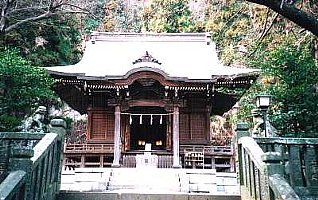
Goryo Jinja Shrine |
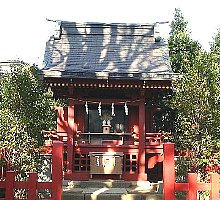
Moto Hachiman Shrine |
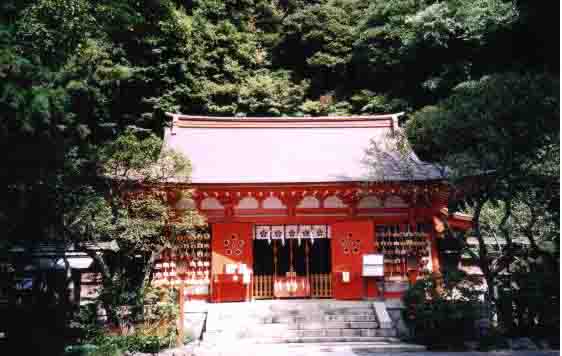
Egara Tenjin Shrine |
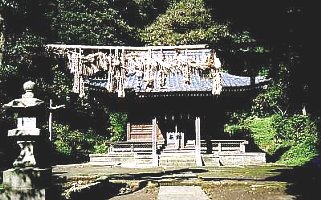
Hakusan Jinja Shrine |
Emergence of the warrior class
In the 11th century emerged the warrior class, who would control the country for some 700 years. The Minamoto (源) (or Genji) and the Taira (平) (or Heishi) were the two major clans famous for their deep-seated rivalry. The two houses had imperial origins. To cope with the financial difficulty of supporting numerous princes and princesses, some of these nobles were given new surnames and became independent.Taira (平) clan, once the highest ranking in the imperial court
Taira no Takamochi (平高望, ?-?), a great-grandson of Emperor Kammu (桓武天皇, 737-806), paved the way for the prosperity of the Taira clan, becoming a vice-provincial official around 890 in what is now part of present-day Chiba Prefecture. After fulfilling his duties, he settled there instead of returning to Kyoto. His sons and descendants had assumed various posts and wielded power in the Kanto region. Among them were the Miura (三浦), Wada (和田), Hatakeyama (畠山), Chiba (千葉), Kazusa (上総), and Kajiwara (梶原) clans. Although they were descendants of the Taira, these families played major roles when Minamoto no Yoritomo (源頼朝, 1147-1199) established the Kamakura government.In Kyoto the Taira gained power among the warrior class in the 12th century. Taira no Kiyomori (平清盛, 1118-1181) made his family the most prominent among the warrior class and controlled the imperial court. The Taira clan is also called Heishi (平氏) or Heike (平家).
Minamoto (源) clan, rival of the Taira
The first Minamoto clan was an offshoot of Emperor Saga(嵯峨天皇, 786-842). Some subsequent emperors did likewise, so that many others came to bear the Minamoto name and a number of sub-families were created. The most famous of these were the Seiwa (清和), Murakami (村上), Saga (嵯峨), and Uda (宇多).Minanoto no Yorinobu (源頼信, 968-1048), was appointed vice-governor of present-day Yamanashi Prefecture. Sent to quash the rebellion of Taira no Tadatsune in the Kanto region, he successfully carried out his mission, thereby establishing a Minamoto foothold in Kanto early in the 11th century.
Two wars in the Tohoku region helped the Minamoto gain further fame. The first, called Zenkunen no Eki (前九年の役), the Earlier Nine Years' War, was waged from 1051 to 1062. Minamoto no Yoriyoshi (源頼義, 988-1075), the son of Yorinobu, and Yoriyoshi's son, Minamoto no Yoshiie (源義家, 1039-1106), were sent to subdue the area.
Tsurugaoka Hachimangu Shrine, now one of the main landmarks in Kamakura, was built around this time. Yoriyoshi's prayer for victory in the above-mentioned war, offered at the Iwashimizu Hachimangu Shrine (石清水八幡宮) in Kyoto prior to his departure, had proven so successful that he secretly brought the God of Hachiman to Kamakura by "dividing" its sacred spirit and had a shrine built at Yui-go (由比郷, in present-day Zaimokuza) in 1063. This took place when he stopped in Kamakura on his way back to Kyoto after his victory.
In 1083, Yoshiie was appointed governor of the present-day eastern part of the Tohoku region. He intervened in the struggle in 1083 and ended the war in 1087. This second war was called Gosannen no Eki (後三年の役), the Later Three Years' War. The ties between the Minamoto and Kamakura were further strengthened by Yoshiie's efforts to repair the Hachiman Shrine in Kamakura in 1081. The Minamoto clan is also called Genji (源氏).
Supremacy of Taira over Minamoto
After Yoshiie, his son and grandson were not successful. But Minamoto no Yoshitomo (源義朝, 1123-60), Yoshiie's great-grandson and the father of Yoritomo, came next and regained power in eastern Japan. Records dating from 1145 state that his residence, which had been passed down for generations, was on land in present-day Ogigayatsu (扇ケ谷), and was where Jufukuji Temple (寿福寺) is now located.Yoshitomo, together with Kiyomori, gained victory in an imperial court battle, called the Hogen Disturbance (保元の乱) in 1156. The cooperative relationship between the two, however, was short-lived. Yoshitomo led a rebellion, the Heiji Disturbance, (平治の乱), against Kiyomori in 1159, but was defeated and forced to leave Kyoto. During his flight to the east, Yoshitomo sought shelter at the house of a friend's relative, but was treacherously murdered there. Minamoto no Yoritomo, a son of Yoshitomo, was captured, sent back to Kyoto, then exiled to Izu. Yoritomo had to endure a painful position for 20 years until he succeeded in destroying the Taira and establishing the Kamakura government.
After the Heiji Disturbance, the Taira became more prosperous by further gaining ground at court. The Taira clan controlled the court politically and militarily, with family members holding high official posts. Kiyomori was promoted to the position of Daijo Daijin (太政大臣), Grand Minister of State, and his grandson became Emperor Antoku (安徳天皇, 1178-85).
Emperor Go-Shirakawa's resentment of the Taira (後白河天皇, 1127-92)
The Taira lived in splendor, boasting that no one other than members of their family was worth being called "human." The Taira's eminence and power were bitterly resented by Emperor Go-Shirakawa and his courtiers. Prince Mochihito (以仁王, 1151-80), the second (or third) son of the emperor was among them, having been forced to give up his hopes of becoming emperor by the enthronement of Emperor Antoku, a grandson of Taira no Kiyomori.At long last, in 1180, Prince Mochihito issued an edict calling for an uprising against the Taira. The arrogant and arbitrary rule of the Taira was cited as justification for the Minamoto to wage war against them.
Minamoto no Yoritomo's declaration of war against the Taira
Armed with the edict from Prince Mochihito, Yoritomo declared war in August. Yoritomo's successful progress, leading to his establishment of the military government, must be traced back to his youth.When Yoritomo fought in a battle led by his father, Yoshitomo, in 1159, he was only 13 years old. His father was defeated and soon murdered on their way east from Kyoto. Yoritomo was captured, but accidentally saved, then exiled to Izu (present-day eastern part of Shizuoka Prefecture).
During this period in Izu, Yoritomo came under the custody of Hojo Tokimasa (北条時政, 1138-1215), who would become his father-in-law: he later married Tokimasa's daughter Hojo Masako (北条政子). In spite of an unfavorable situation, Yoritomo gained support, among othres, from the Hiki family (比企) from which his wet nurse, Hiki no Ama (比企尼), had come. Nevertheless, Yoritomo still had to spend some 20 years in exile before declaring war against the Taira in 1180.
It was Masako rather than Yoritomo who wished to marry. From that time on, Yoritomo, with the assistance of Tokimasa, began preparing for war against the Taira. In August 1180, Yoritomo declared war. In the first battle at Mt. Ishibashi (石橋山) near Hakone (箱根), Yoritomo was easily defeated and fled to the southern part of present-day Chiba Prefecture (千葉県) in mid-September. Yoritomo, however, rose like a phoenix. Some two months later, Yoritomo, accompanied by his followers, marched into Kamakura and proceeded to establish his offices at the site called Okura (大蔵). (The end of this part)